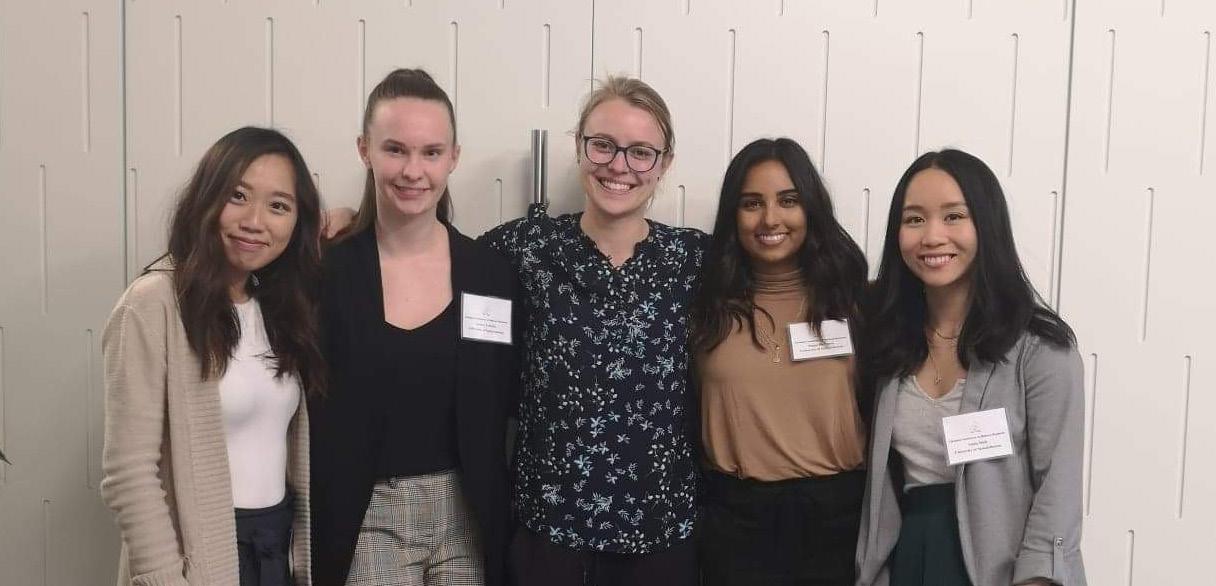
4 minute read
Students stand in solidarity with patients, communities they serve
By Jessica Froehlich, Class of 2022 (pictured second from left)
Advocacy has a long tradition in medicine. German physician Rudolph Virchow, widely regarded as the founder of social medicine, talked about how “physicians are the natural attorneys of the poor” and “politics is nothing else but medicine on a larger scale.” The privilege of being with patients through their times of struggle and sorrow, while bearing witness to their courageous stories, is one we can never take for granted. And when we learn of the health inequities our patients experience, it is our duty to stand beside them and to act in the face of injustice.
I went into medical school wanting to learn as much as I could about socially responsive care and to make a meaningful difference in my community. I was naturally drawn to work based in community engagement and soon found myself being inspired and mentored by like-minded individuals. In my first year of medical school, I joined my peers in advocating for universal coverage for the medical abortion pill, Mifegymiso, which the Saskatchewan government agreed to begin paying for in June 2019. At that time, Saskatchewan was one of only two provinces that didn’t provide universal coverage, leaving few options for people in need of this time-sensitive service.
As part of this campaign, we gathered stories and support from physicians, community organizations, and individuals with personal experiences. They told of the barriers people with uteruses are forced to overcome and the impossible decisions they have to make to access basic reproductive health care. These were not stories of distress, but of resourcefulness and resilience. This was one of the most meaningful experiences I’ve had as a medical student. I was able to see the necessity of working with governments to improve health equity through education and policy changes, as well as the need to increase discussion around sexual and reproductive health to challenge the stigma often associated with it.
Last fall the Saskatchewan Medical Association voted unanimously to support the call for no-cost contraception, after the issue was brought forward by Dr. Christine Lett, an obstetrician and gynecologist in Regina. Around the same time, I started working with a group of 12 amazing medical students from across the country to conduct research and consultations with expert stakeholders on the need for universal access to contraception, as part of the Canadian Federation of Medical Students Day of Action. We shared our results with more than 70 medical students and met with parliamentarians in Ottawa to call attention to the issue.
We engaged in conversations about how access to contraception is a human right which empowers people, improves health outcomes, and leads to significant cost savings. The most significant barrier to accessing contraception is cost, especially for the more efficacious forms such as the hormonal IUD, which is upwards of $350. Unintended pregnancies cost Canada more than $320 million annually through deliveries and terminations alone. This could be decreased by $35 million if just 10% more people had access to intrauterine devices(1). Furthermore, other countries have shown overall health system savings of seven dollars for every dollar spent on contraception(2) .
As part of this project, our group also discussed how misconceptions about contraception and stigmatization of reproductive health are a large part of the problem(3). Lastly, we discussed the need for ‘task-shifting’ to improve patients’ access to providers of contraception, which is recommended by world leaders such as the Society of Obstetricians and Gynecologists of Canada(4) and the World Health Organization(5). We echoed the calls of many individuals and organizations who have been dedicated to this cause for years and have worked to raise awareness of how no-cost contraception will benefit us all.
Since the Day of Action, I have had the opportunity to continue this work provincially alongside Dr. Lett and Dr. Tin Yen, who have been amazing supports and mentors. I’ve met students, physicians, researchers, and community workers who are dedicated to improving health equity and who inspire me to imagine a world where access to care is not determined by where we live or our ability to pay.
I cannot imagine learning medicine without also learning the many ways to stand in solidarity with the communities we serve. Political advocacy is but one. When medical professionals apply their clinical knowledge and front-line experience to societal advocacy, it can be very powerful. As medical students we have a unique perspective, and our active involvement in politics is one of the most effective ways we can improve the health of our patients. ◆
1. Black AY, et al. Unintended Pregnancies in Canada: Estimating Direct Cost, Role of Imperfect Adherence, and the Potential Impact of Increased Use of Long-Acting Reversible Contraceptives. Journal of Obstetrics and Gynaecology Canada. 2015;37(12):1086-97.
2. Frost JJ, et al. Return on investment: a fuller assessment of the benefits and cost savings of the US publicly funded family planning program. Milbank Quarterly. 2014;92(4):696–749.
3. Howatt K, et al. Improving Physician Knowledge: A Necessary but Not Sufficient Requirement of Improving Intrauterine Contraception Access in Canada. Journal of Obstetrics and Gynaecology Canada. 2019;41(8):1115-24.
4. Black et al. Canadian Contraception Consensus (Part 1 of 4) Contraception in Canada. Journal of Obstetrics and Gynaecology Canada. 2015;37(10): 936-8.
5. World Health Organization. Task sharing to improve access to Family Planning/Contraception. 2017.

